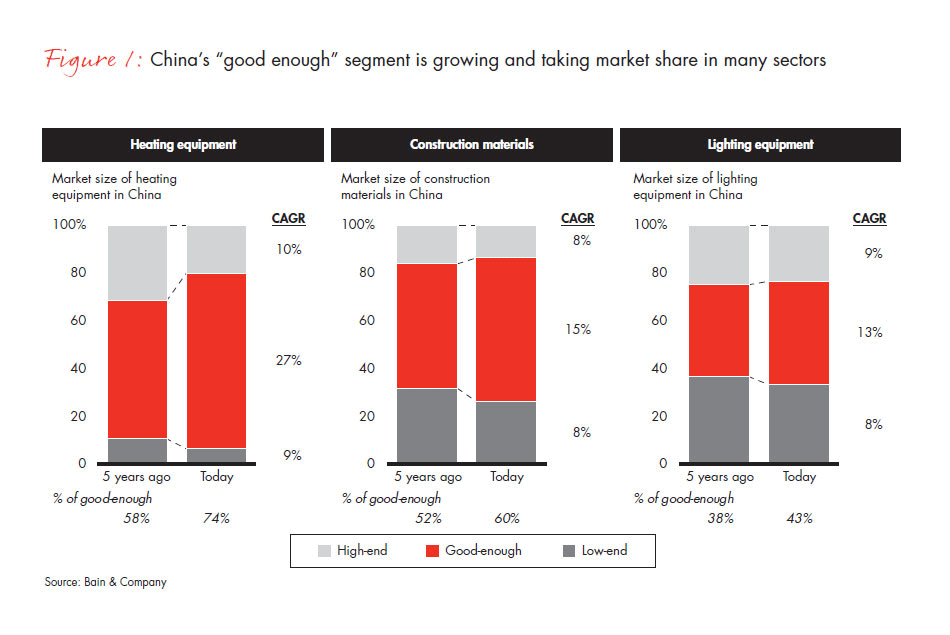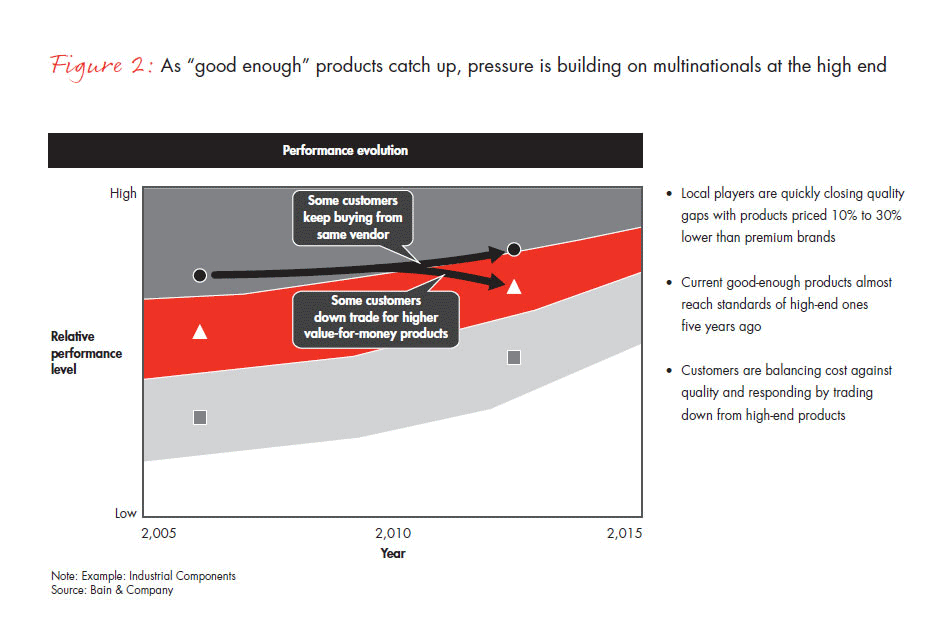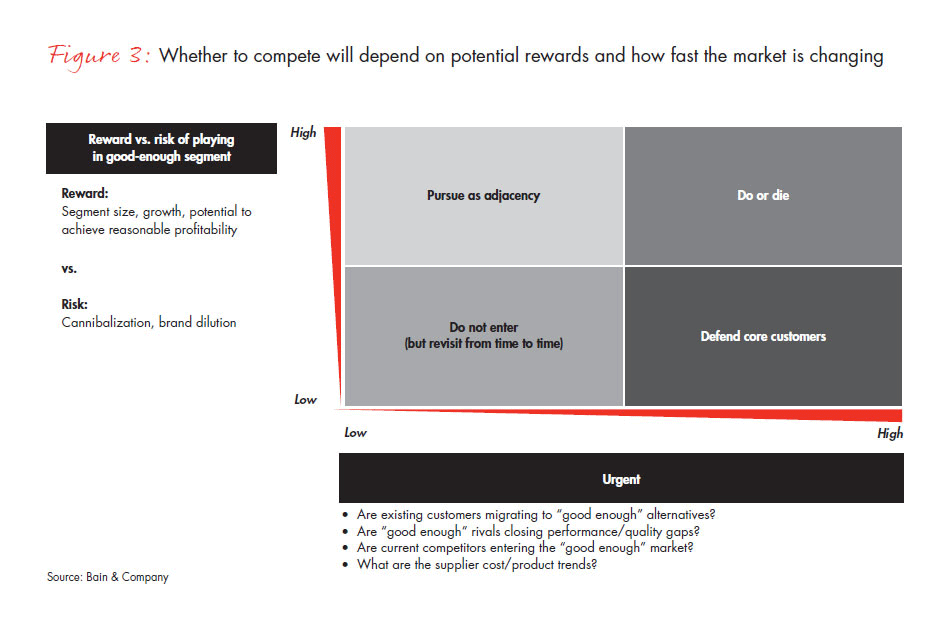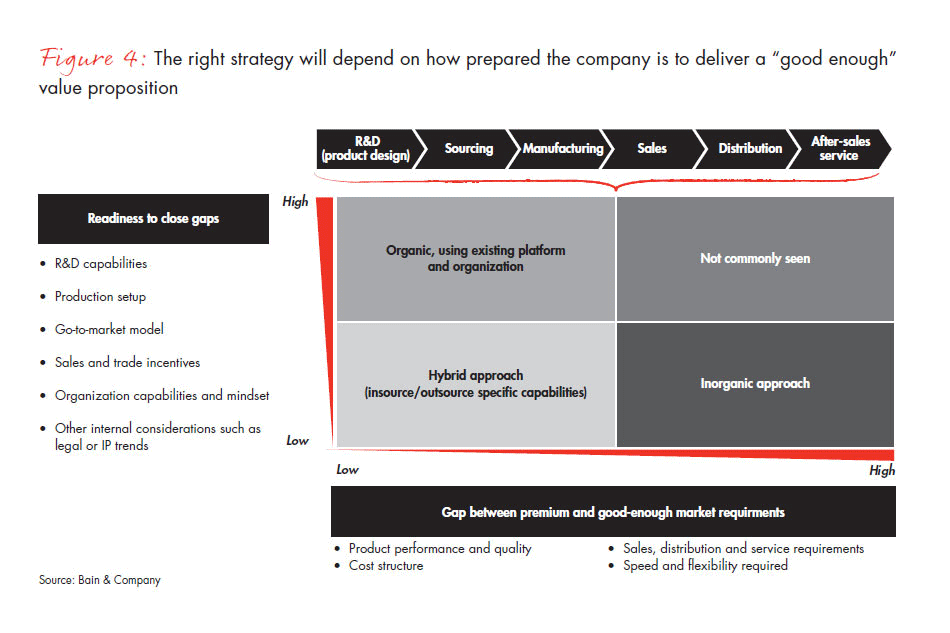Brief
In the two decades since Grundfos opened its first office in China, the world’s largest producer of industrial and residential pumps has built an enviable position. With approximately $300 million in 2012 sales, it dominates the market’s high end with a share approaching 50%. And because its broad range of products offers higher-quality and more features, it has thrived despite prices that are as much as two times higher than the local competition’s.
But over the last several years, the Danish company’s market has changed dramatically in ways that will look familiar to anybody doing business in China today. Though Grundfos continues to flourish at the high end, it is feeling increasing pressure from below as local manufacturers make their way down the learning curve. These new rivals have rapidly narrowed the quality gap with well-designed, low-cost products that are “good enough” to appeal to a growing number of customers in China’s burgeoning middle market. As they’ve stretched toward the premium segment, Grundfos has faced a critical decision: Should it hunker down to defend its high-end position? Or should it engage the local competition head-on by investing strategically to build a good-enough business of its own?
For Grundfos, like so many other multinationals coping with the good-enough challenge in China, the solution might be a combination of the two. Not only must companies encountering local competition protect their hard-won positions at the high end, but if they fail to engage in the middle, they risk being shut out of one of the world’s most vibrant developing markets. Although reshaping a large, high-cost operation to compete in an unfamiliar, sometimes hostile, environment is a complex challenge, a growing number of companies see little choice. The question most leaders face is not whether they should play in the good-enough market, but where to play and how to win.
By now, the contours of China’s exploding good-enough market are well known. In almost every sector, from construction equipment to financial information, local companies have matured sufficiently to offer products that are much more competitive than in the past (see Figure 1). In most cases they aren’t competing directly with foreign incumbents’ premium brands—at least not yet. But by introducing lower-priced products that are acceptable enough to many customers in terms of quality and features, they are scooping up market share in the middle and increasingly enticing some higher-end customers to trade down (see Figure 2).


Large companies already thriving in China’s premium space have long wrestled with the considerable risks of moving down-market to meet these new competitors. The threat of cannibalizing their own high-end products is a real one, and many lack confidence in their ability to profit in a lower-cost environment. But the past five years have seen a clear shift in how companies like Grundfos approach the challenge. Increasingly, they view China’s good-enough market as a historic opportunity and are thinking creatively about how they can exploit it profitably without threatening their high-end franchises.
In part, the new thinking reflects a better understanding of the local market. As they’ve gained experience on the ground in China, multinationals are more familiar with its challenges. They are not only seeing increased promise in the middle, but as the economy matures, they are finding higher-quality sourcing and partnership opportunities that can help them reduce costs. Many also recognize that mastering the risks and opportunities presented by China’s middle market can pay important dividends elsewhere. More companies, like General Electric in medical equipment and American Standard in bathroom and kitchen fixtures, are using the good-enough capabilities they developed in China to export both products and strategy globally to other markets with similar challenges. And by engaging directly with Chinese competitors at home, they hope to forestall the day when they will encounter them abroad.
Entering the good-enough market is clearly not a priority for all companies, nor should it be. The decision depends on how vibrant the opportunity is for a given set of products and how quickly local competition is moving up the value scale (see Figure 3). Companies experiencing stable growth in the premium segment, or those that thrive on the caché of expensive luxury brands, may see no reason to move down-market. For them, it may be more important to funnel new investment into research and development (R&D), design or marketing to protect and expand their dominance at the high end.

For most large foreign companies, however, the future looks decidedly less secure. As local competition looms, the challenge is to turn a threat into an opportunity by devising creative, lower-cost strategies that will allow them to compete effectively in the middle market without sacrificing profits. The essential first step in deciding where to play and how to win is a clear-eyed appraisal of how the company should tailor its existing capabilities and product offerings for different customer needs and a very different competitive environment. The most successful strategies share some common elements:
- They start with a clear, differentiated value proposition that avoids cannibalization of premium businesses.
- They incorporate a careful analysis of the company’s existing platform to determine whether it can deliver a lower-cost solution organically with speed and agility.
- If not, they compensate resourcefully by considering a full range of options, including local sourcing, partnerships, M&A or a blend of all three.
- They secure a strong commitment from the global or regional office to provide a significant multi-year investment.
Multinationals have gravitated to China’s premium market for good reason: The nation’s top echelon of sophisticated, well-heeled customers provides the most natural fit for the high-quality, fully featured products they already sell elsewhere around the world. As these same companies consider moving down-market, however, this strength becomes a potential weakness. They typically have worked hard to hone their capabilities—from R&D through supply chain and operations—to deliver premium products at high price points, not low-cost alternatives. They may or may not have a large presence on the ground in China and they may be ill-suited both culturally and organizationally to compete in a market that demands flexibility, strong local knowledge and swift decision making.
How quickly a company can shift gears will most often determine the shape of a winning strategy. The most successful leadership teams begin their analysis with a pair of seemingly simple questions: How wide is the gap between our premium products and our prospective good-enough offerings? And how ready are we to close that gap across the full range of our capabilities? The answers to these questions vary widely depending on the particulars of each company’s structure, product complexity and culture. But in our experience, they suggest three broad approaches to building a more flexible, low-cost value chain—an organic approach, which relies primarily on internal capabilities; an inorganic approach, which leans heavily on M&A; and a hybrid approach, which blends internal capabilities with external partnerships or acquisitions to arrive at the right business model (see Figure 4).

A gap in price is the most obvious difference between good-enough and more fully featured premium offerings. But in most cases, companies need to focus their attention on the underlying cost structure and organizational issues. Requirements for everything from supply chain to quality assurance procedures may be poles apart. Targeting different geographies or customer segments may call for new sales and distribution channels, as well as a new service scheme. In all aspects of production and delivery, the new product might require significantly more speed and flexibility to contend with smaller, more nimble competitors.
Whether a company can address these gaps quickly enough to seize a given opportunity depends partly on how wide the gap is and partly on the company’s willingness and ability to change—sometimes dramatically. While many companies may see an opportunity to “de-spec” their topline products to meet good-enough standards, doing so will likely reverberate across the company’s entire value chain. This is especially true if the threat of cannibalization requires creating an unaffiliated brand supported by an entirely separate organization. Can the R&D group understand the new market and is it flexible enough to keep pace? Is the sourcing and manufacturing platform efficient enough to drive down production costs? Can the sales organization adjust to a new kind of customer and is the compensation scheme appropriate? Are distribution and service up to the challenge?
If the answer to most of these questions is “yes,” an organic approach may be the most appealing option. Modifying an existing organization to create a new low-cost production and selling model assumes a high degree of flexibility. It typically means working with suppliers and retooling production to achieve lower costs. Downstream, it will require refocusing the sales team and distribution network to target a customer with a very different set of expectations. But by avoiding complicated partnerships or expensive acquisitions, adjusting internally may require a smaller investment of time and capital. It also may offer a much higher degree of control over the new strategy.
When Samsonite launched a major good-enough initiative in 2008, it chose an organic approach, confident that it could tailor its existing strategy with relative ease. The venerable luggage company had entered China in 1997 and had already been selling three brands in China—Black Label, aimed at the ultra-premium business segment; Samsonite, which appealed to business and casual travelers; and American Tourister, positioned as a less-expensive, scaled-down alternative. The two premium brands had established strong positions at the high end. But China’s rapidly expanding middle class was increasingly responsible for most of the growth in the luggage market.
Samsonite knew it could use American Tourister and a select group of Samsonite-branded products to attack the middle more aggressively. But that would require several crucial adjustments to the company’s business model. For one thing, Samsonite’s sales channel was focused squarely on the high-end department and specialty stores in China’s biggest coastal cities, which made sense for the Black Label and Samsonite brands, but limited the growth of American Tourister. The solution was to develop a new go-to-market strategy for the lower-end brand focused on hypermarts like Tesco and Carrefour. Using regional distributors and franchisees with key contacts in this big-box retail segment, Samsonite built a much broader American Tourister distribution channel that allowed it to quickly capture mid-market growth and penetrate lower-tier cities. The company also began selling American Tourister directly to consumers online using a dedicated website.
What Samsonite didn’t do was create an entirely separate organization for American Tourister. The bargain brand remains part of the overall Samsonite sales structure, and the company was agile enough to make the right adjustments internally to reduce costs and improve customer focus for American Tourister. Moving the brand to where the growth is has so far paid off: Powered by American Tourister, Samsonite’s sales have grown rapidly since 2009. The strong momentum helped the company raise $1 billion on the Hong Kong stock exchange in 2011 to fund further expansion in China.
Although Samsonite made the organic approach work, closing the gap internally between premium and good-enough product offerings may be less feasible for many other multinationals. They may lack sufficient market knowledge to address local needs. Their operations may be too complex or finely tuned to easily adjust to a lower cost structure. Their sales organization and distribution framework might be ill-suited to move higher-volume products cheaply. Or they may be unprepared organizationally and culturally to move quickly enough to seize the new opportunity.
For these companies, an inorganic approach using partnerships or acquisitions often provides the quickest, most efficient solution. As with any acquisition strategy, the integration and management challenges are significant. But finding the right partner can make up for the risk by providing local knowledge and networks, along with a ready-made, low-cost platform.
AB Volvo came to that conclusion in 2007 when it invested $80 million to buy a 70% stake in Lingong, a leading construction equipment maker in northern China. Volvo’s fully featured construction equipment had won a strong following in China’s premium segment well before it ever focused its sights on Lingong. But to keep expanding, Volvo knew it needed a strong presence in the construction equipment middle market, which was growing at a significantly faster clip and already accounted for approximately 80% of equipment sales in China.
As Volvo assessed its ability to compete in the good-enough market, it saw hurdles from one end of its value chain to the other. Because its complex global production process was highly calibrated to deliver top-end equipment at a premium price, creating a low-cost manufacturing platform would be a steep challenge. The Swedish company also lacked experience and customer knowledge in the middle market, making it difficult to design and deliver competitive products. At the same time, it was clear that local manufacturers like Lingong had become extremely capable. They had done a remarkable job of scrambling up the learning curve to close quality gaps, becoming fast, agile competitors that had better relationships with key customers in the good-enough market. Investing in one would be the most efficient way to get into the game quickly while buffering the premium Volvo brand from the threat of cannibalization.
Volvo’s Lingong investment has quickly proved itself out. The acquired company’s product line and extensive network of Tier 1 distributors has given Volvo a strong presence across a much wider swath of China’s construction equipment market. In 2007, Volvo increased its scope even further by purchasing the road-construction unit of Ingersoll-Rand for $1.3 billion and folding Ingersoll’s Wuxi plant into Lingong’s good-enough portfolio. The parent company’s expertise has helped Lingong improve profitability by lowering procurement costs, rationalizing its dealer network and reducing overhead. In the six years since the acquisition, Lingong’s sales and gross margin have grown rapidly.
While adapting existing operations or entering the good-enough market through a strategic acquisition may be the cleanest way to compete at lower costs, an increasing number of companies are choosing a middle route. They are breaking down the challenge into pieces and devising a hybrid approach that takes advantage of both internal capabilities and external resources. A hybrid strategy can give a company the ability to maintain control over critical functions while using outsourcing, partnerships and M&A selectively to fill in the gaps. It can also help target specific opportunities as they arise while maintaining flexibility as conditions change.
As Grundfos began to feel pressure in its premium pump business, it launched a careful analysis of both where the pressure was coming from and what assets it had on hand that would allow it to respond. Local players were making inroads with well-designed products that they priced 50% below Grundfos’s offerings. But they were largely focused on the residential pump business, which gave Grundfos the ability to sharply focus its good-enough strategy.
Like Volvo, Grundfos was loath to dilute its high-end brand or cannibalize its own sales by introducing lower-end versions of its existing products. It also knew that closing the price gap with good-enough competition would likely require a separate, lower-cost operation and a different go-to-market model. Making an acquisition or striking a partnership might have made sense. But as Grundfos reviewed its options it saw another solution: It decided to create an autonomous, lower-priced brand called Emerco using the assets of DAB, a middle-market Italian pump manufacturer it had acquired in the 1990s.
DAB had been exporting products from a plant in Qingdao since 2006 but had little presence in China’s domestic market. What it offered Grundfos was the opportunity to build a value chain dedicated to Emerco. The new brand would include a specific mix of mid-end products aimed squarely at the residential segment. Its prices would be 20% to 30% lower than those charged for the premium Grundfos brand but still 10% higher than local offerings. Emerco would avoid distributors and instead target residential installers and retail customers directly. It would also start with a few carefully selected cities and expand deliberately from there.
Grundfos launched Emerco in 2012 with several clear advantages. One was that Grundfos, through DAB, had a global R&D operation that was flexible enough to design certain key Emerco products exclusively for the China market. DAB also had the plant in Qingdao, which gave Grundfos a head start on building a low-cost operation locally. With the exception of an important flow switch that comes from South Korea to ensure quality, Grundfos has been able to find low-cost local sources for 80% of its Emerco materials and components. And because the Qingdao plant can also manufacture some Grundfos pumps, the increased volume has allowed it to reduce raw material costs by as much as 4% a year.
Grundfos was careful to create maximum distance between the Emerco and Grundfos brands. While Grundfos’s China headquarters is in Shanghai, Emerco has offices in Beijing. Its marketing makes no mention of Grundfos and its website features no links or references to the parent company. That helps protect the premium brand, but a separate operation also saves costs. The new company ships directly from the plant, eliminating distributors and reducing the need for warehoused inventory. A two-year warranty is good-enough to match the local competition, as is a policy to replace products that don’t perform instead of providing maintenance or repair service to end users.
The Emerco strategy is still in its early days, but initial results are promising. It has achieved double-digit growth in its existing regions, and research shows it has built both strong brand awareness and customer satisfaction. There is also ample room to run: Emerco is pushing hard to boost market share in existing cities by moving into more outlets. In 2013 it moved into seven new regions where the good-enough market is strong.
What companies like Grundfos, Volvo and Samsonite are finding is that the investment they are making in China’s good-enough segment is well worth the risk of playing in an unfamiliar market. By carefully assessing where they can offer a clearly differentiated value proposition and then puzzling together creative, low-cost strategies that can deliver, they are both protecting their considerable investment in China’s high end and opening up a rich new opportunity to capture growth in the middle.
But most multinationals are also recognizing something else: The implications of the good-enough challenge stretch well beyond China. As global powerhouses like Haier and Lenovo have amply demonstrated, the skills and scale local Chinese companies develop at home eventually embolden many to expand abroad, offering low-cost, flexible solutions that make them formidable competitors in markets around the world. Winning on the good-enough battlefield is becoming increasingly important to succeeding in China. But for many multinationals it may also represent the table stakes for staying competitive globally.
Raymond Tsang is a partner in Bain & Company’s Shanghai office and a leader in the firm’s Performance Improvement practice. Kevin Chong is a partner in Bain’s Shanghai office and leader of the firm’s Strategy practice in Greater China.



